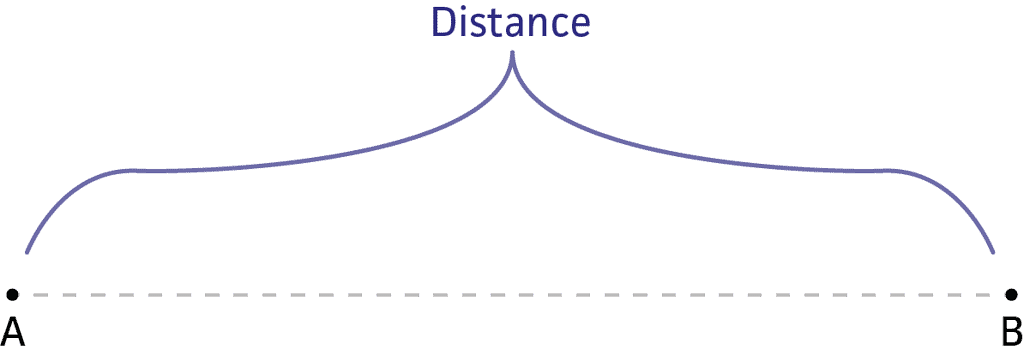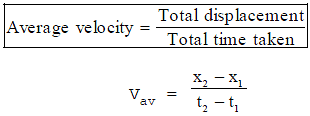Describing Motion and Related Concepts | Science Class 9 PDF Download
Describing Motion
 Motion of a Ball
Motion of a Ball
In physics, motion is the phenomenon in which an object changes its position over time. Motion is mathematically described in terms of displacement, distance, velocity, acceleration, speed, and time. The motion of a body is observed by attaching a frame of reference to an observer and measuring the change in position of the body relative to that frame with change in time.
Reference point and Reference Frame
- To describe the position of an object we need a reference point or origin. An object may seem to be moving to one observer and stationary to another.
- Example: A passenger inside a bus sees the other passengers to be at rest, whereas an observer outside the bus sees the passengers to be in motion.
- In order to make observations easy, a convention or a common reference point or frame is needed. All objects must be in the same reference frame.
Motion
- If we look around us, we find that there are number of objects which are in motion. An object is said to be in motion if it changes its position with the passage of time. In other words, the movement of an object is known as the motion of the object.
- Now observe the following bodies or objects and we will be able to understand the meaning of the term "motion". Cars, cycles, motorcycles, scooters, buses, rickshaws, trucks etc. running on the road, Birds flying in the sky, Fish swimming in water. All these objects are in motion. Very small objects like atoms and molecules and very large objects like planets, stars and galaxies are in motion.
- Thus, all objects ranging from the smallest atom to the largest galaxy are in continuous motion.
Types of Motion
1. Linear Motion
- A body has linear motion if it moves in a straight line or path.
- Example:
(i) Motion of a moving car on a straight road.
(ii) Motion of a ball dropped from the roof of a building.

- A body has circular motion if it moves around a fixed point.
- A vertical passing through the fixed point around which the body moves is known as axis of rotation.
- Example:
(i) Motion of an electric fan.
(ii) Motion of merry-go-round
(iii) Motion of a spinning top.
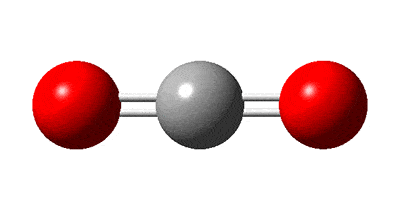
- A body has vibratory motion if it moves to and fro about a fixed point.
- Examples:
(i) Motion of a pendulum of a wall clock.
(ii) Motion of a simple pendulum.
Motion in Living and Non-living Objects
- It is a common observation that all living objects, whether plants or animals can move in some way or the other. The motion in animals is more apparent than the motion in plants.
- The motion in animals is called Locomotion.
- Plants also move but their motion is not apparent as they cannot move from place to place. Their motion takes place in parts. As a plant grows so does its roots and its leaves.
Mechanics
The branch of physics which deals with the motion of non-living objects in everyday life is called mechanics or Classical mechanics.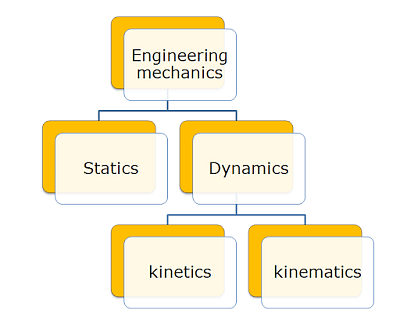
It is of two types:
1. Statics
- Statics deals with bodies at rest under the effect of different forces.
2. Dynamics
- Dynamics deals with the bodies in motion.
- It is further of two types:
(a) Kinematics
Kinematics, which is derived from a Greek word kinema meaning motion, is a branch of Physics, which deals with the motion of a body without taking into account the cause of motion.(b) Dynamics Proper
Dynamics proper, which is derived from a Greek word dyna meaning power it is a branch of Physics, which deals with the motion of bodies by taking into account the cause of motion (force).
Distance and Displacement
Distance
- The length of the actual path between the initial and the final position of a moving object in the given time interval is known as the distance travelled by the object.

- Distance = Length of path (AB)
- Distance is a scalar quantity.
- Units:
(i) In SI system: metre (m)
(ii) In CGS system: centimetre (cm)
(iii) Large unit Kilometre (km)
Displacement
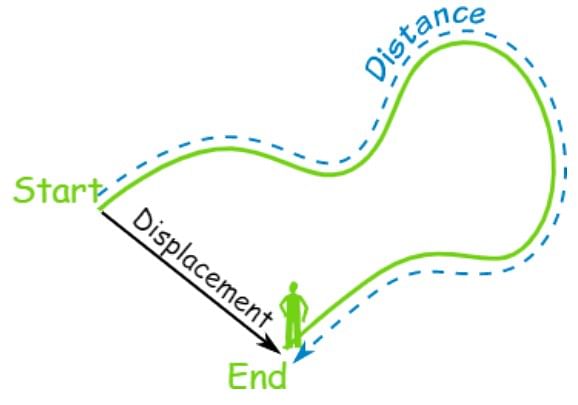
- The shortest distance between the initial position and the final position of a moving object in the given interval of time from initial to the final position of the object is known as the displacement of the object.
- Displacement of an object may also be defined as the change in position of the object in a particular direction. That is, Displacement of an object = Final position – Initial position of the object.
- Displacement of an object may be zero but the distance travelled by the object in never zero.
- Distance travelled by an object is either equal or greater than the magnitude of displacement of the object.

- Displacement = Length of path II (AB) A to B, displacement is vector quantities.
- Units:
(i) In SI system: metre (m)
(ii) In CGS system : centimetre (cm)
Example:
A train goes from station A to station B as shown in the figure. 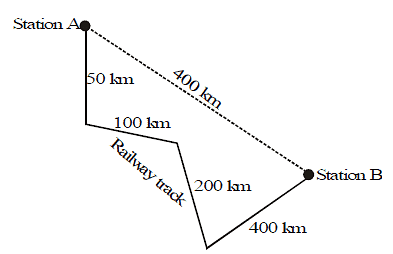
Calculate:
(i) the distance travelled by train
(ii) the magnitude of the displacement of the train on reaching station B.
Solution:
(i) Distance travelled by the train = 50 + 100 + 200 + 400 = 750 km.
(ii) Magnitude of the displacement in going from station A to station B = 400 km.
Differences between Distance and Displacement
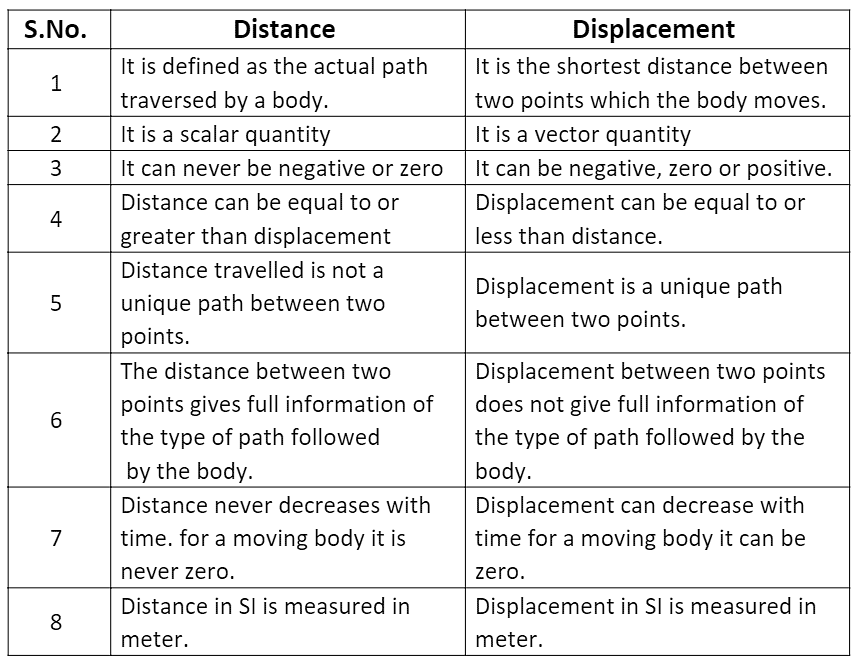
Uniform and Non-uniform Motion
- A moving body may cover equal distances in equal intervals of time or different distances in equal intervals of time.
- On the basis of above assumption, the motion of a body can be classified as uniform motion and non-uniform motion.
Uniform Motion
 Uniform Motion
Uniform Motion
- When a body covers equal distances in equal intervals of time however small may be time intervals, the body is said to describe a uniform motion.
- Examples:
(i) An aeroplane flying at a speed of 600 km/h
(ii) A train running at a speed of 120 km/h
(iii) Light energy travelling at a speed of 3 × 108 m/s
Non-uniform Motion
 Non-uniform Motion
Non-uniform Motion
- When a body covers unequal distances in equal intervals of time, the body is said to be moving with a non-uniform motion.
- Examples:
(i) An aeroplane running on a runway before taking off.
(ii) A freely falling stone under the action of gravity.
(iii) An object thrown vertically upward.
(iv) When the brakes are applied to a moving car.
Speed
- Speed is the rate of change of distance. If a body covers a certain distance in a certain amount of time, its speed is given by
Speed = Distance / Time - Average speed = Total distance travelled / Total time taken
- Units:
(i) In SI system: m/s or ms-1
(ii) In CGS system: cm/s or cms-1
(iii) Other km/h or kmh-1, km/min.
Velocity

- The velocity of a body is the displacement of a body per unit time.
- The displacement covered by a body per unit time or the speed of a body in specified direction is called the velocity.
- Units:
(i) In SI system: m/s or ms-1
(ii) In CGS system: cm/s or cms-1
(iii) Other km/h or kmh-1, km/min.
Uniform Velocity
- When a body covers equal displacement in equal intervals of time, the body is said to be moving with a uniform velocity.
- Conditions for uniform velocity:
(i) The body must cover equal displacement in equal intervals of time.
(ii) The direction of motion of the body should not change. - Examples:
(i) A train running towards south with a speed of 120 km/h.
(ii) An aeroplane flying due north-east with a speed of 600 km/h.
Note
The direction of velocity represents the direction of motion of body.
or
Sign of velocity represents the direction of motion of body.
Non-uniform Velocity/Variable Velocity
- When a body covers unequal displacement in equal intervals of time, the body is said to be moving with variable velocity.
- When a body covers equal distances in equal intervals of time, but its direction changes, then the body is said to be moving with variable velocity.
- Conditions for variable velocity:
(i) It should cover unequal displacement in equal intervals of time.
(ii) It should cover equal distances in equal intervals of time but its direction must change. - Examples:
(i) A car running towards north on a busy road has a variable velocity as the displacement covered by it per unit time changes with change in the road condition.
(ii) The blades of a rotating ceiling fan, a person running around a circular track with constant speed etc. are the example of variable velocity, as the direction of the moving body changes in each case.
Average Velocity
- Total displacement divided by total time is called average velocity.

- The arithmetic mean of initial velocity and final velocity for a given time period, is called average velocity.

Memorize
When a body moves with constant velocity, the average velocity is equal to instantaneous velocity. The body is said to be in uniform motion.
Difference between Speed and Velocity
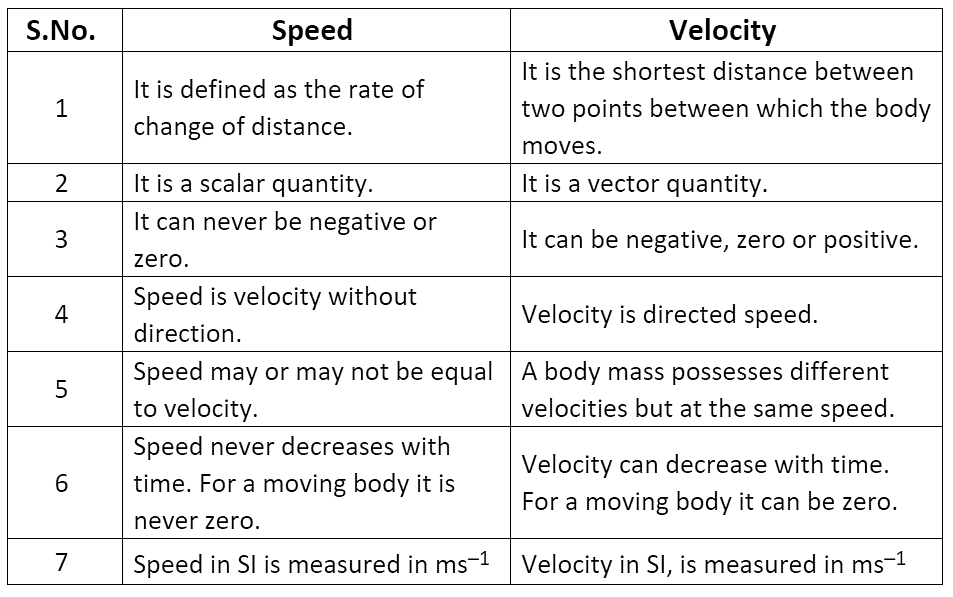
Acceleration

- The rate of change of velocity of a moving body with time is called acceleration.
but change in velocity = final velocity - initial velocity. - If a body moves with uniform velocity, then v = u and then acceleration is zero i.e. a = 0.
- Units:
(i) In SI system is m/s2 or ms-2
(ii) In CGS system is cm/s2 or cms-2
Positive Acceleration
- If the velocity of an object increases with time in the direction of the motion of the object, then the acceleration of the body is known as positive acceleration.
- In this case, the object picks up the speed in a particular direction (i.e., velocity). For example, if an object starts from rest and its velocity goes on increasing with time in the direction of its motion, then the object has positive acceleration.
- The direction of positive acceleration is in the direction of motion of the object.
Negative Acceleration
- If the velocity of an object decreases with time, then the acceleration of the object is known as negative acceleration.
- Example: If an object moving with certain velocity is brought to rest then the object is said to have negative acceleration.
Acceleration without changing Speed
- When an object moves in a circular path with constant speed, then its velocity changes due to the change in the direction of motion of the object. hence, the object is accelerated without changing its speed. In this case, the direction of acceleration is towards the centre of the circular path.
- Positive or negative sign of acceleration always shows the direction of acceleration or direction of force but not represent direction of motion of body.
- Acceleration which opposes the motion of a body is called retardation or negative acceleration.
- If sign of velocity and acceleration are same it means speed of body will always increase.
- If both are opposite, it means speed of body will always decrease.
Uniform Acceleration
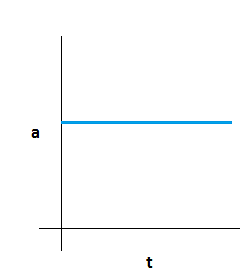 Uniform Acceleration
Uniform Acceleration
- When a body undergoes equal changes in velocity in equal intervals of time, the body is said to be moving with a uniform acceleration
- Examples:
(i) Motion of a freely falling body.
(ii) Motion of a ball rolling down an inclined plane.
Non-uniform Acceleration or Variable Acceleration
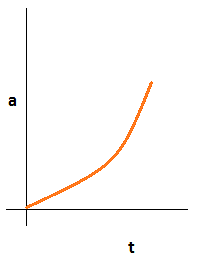 Non-uniform Acceleration
Non-uniform Acceleration
- When a body undergoes an unequal change in velocity in equal intervals of time, the body is said to be moving with non-uniform acceleration.
- Examples:
(i) The motion of a bus leaving or entering the bus stop.
(ii) The motion of a train leaving or entering the platform.
(iii) A car moving on a busy road has non-uniform acceleration.
|
88 videos|369 docs|67 tests
|
FAQs on Describing Motion and Related Concepts - Science Class 9
| 1. What are the different types of motion? |  |
| 2. What is the difference between distance and displacement? |  |
| 3. What is the difference between uniform and non-uniform motion? |  |
| 4. What is acceleration? |  |
| 5. What is the difference between speed and velocity? |  |

|
Explore Courses for Class 9 exam
|

|
